AWS Networking
- Site-to-site VPN
- Direct connect
- VPC Peering
- Transit Gateway
- VPC Endpoints - Gateway
- VPC Endpoint Service, endpoint interface, and PrivateLink
- Gateway Load Balancer (GWLB)
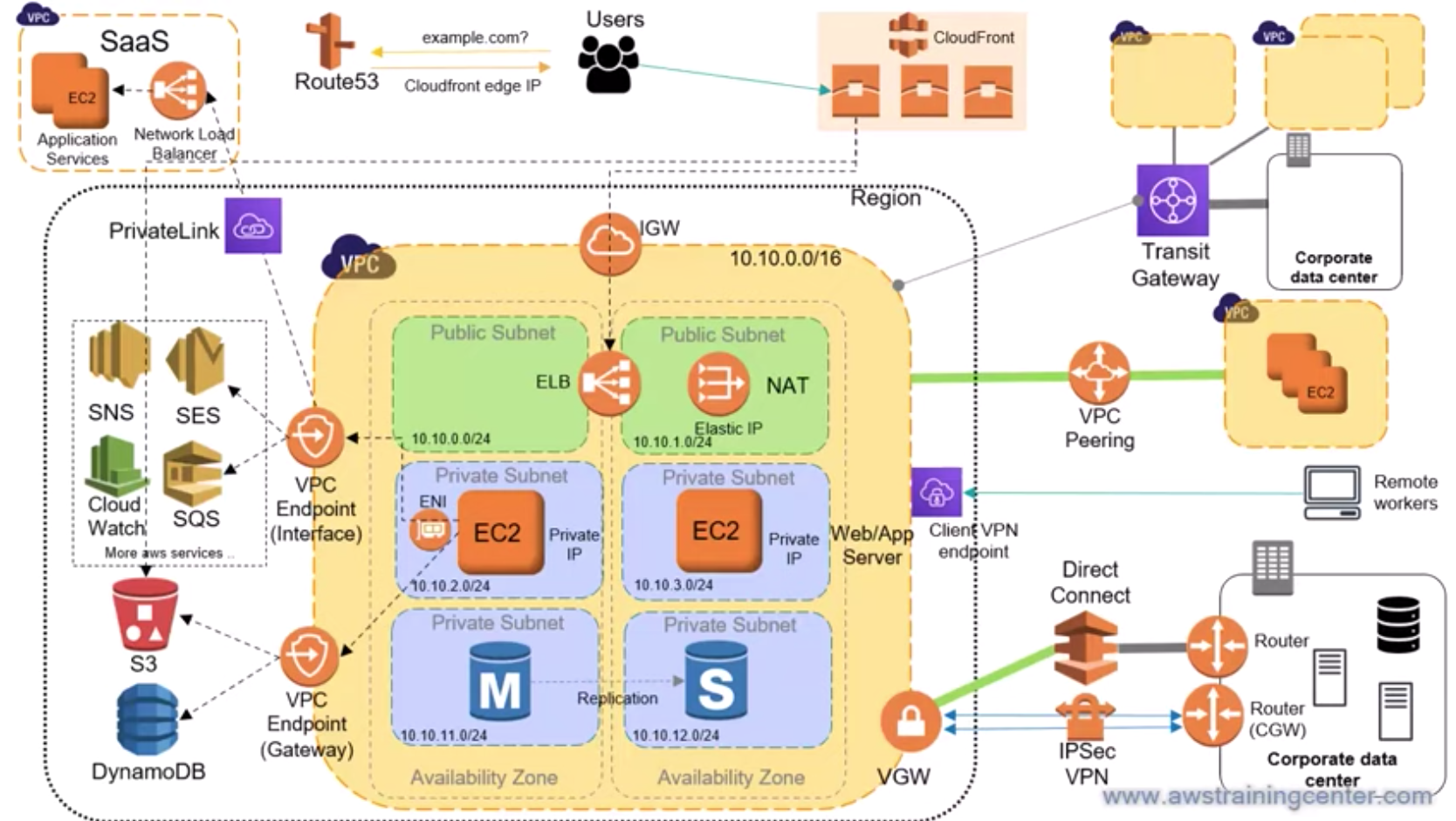
Picture credit: Introduction to AWS Networking
A Site-to-Site VPN connection offers two VPN tunnels between a virtual private gateway (VGW) on the AWS side and a customer gateway (CGW) on the remote (onpremises) side.
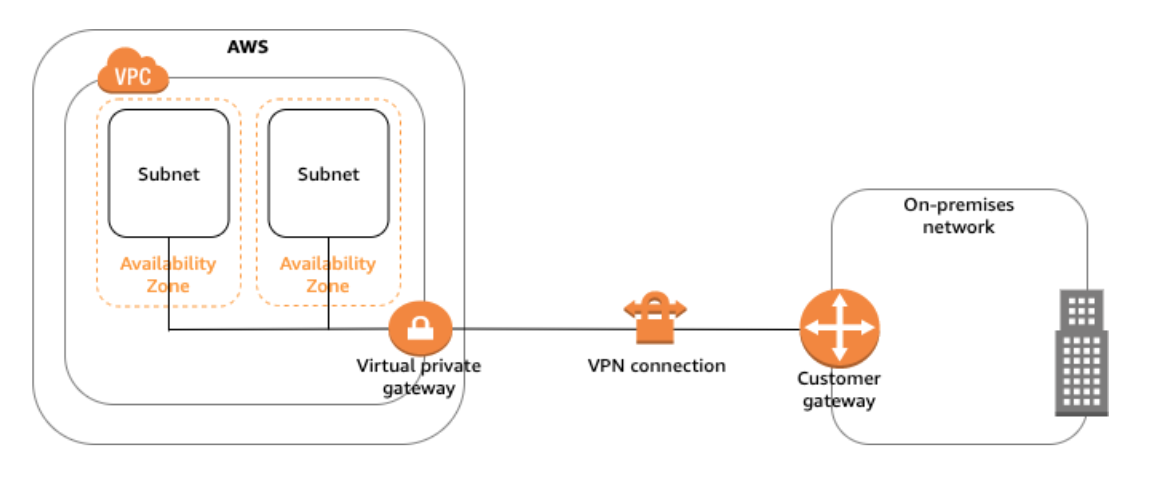
The VPC has an attached virtual private gateway, and our on-premises (remote) network includes a customer gateway device, which we must configure to enable the Site-to-Site VPN connection. We need to set up the routing table so that any traffic from the VPC bound for our network is routed to the virtual private gateway.
Direct Connect makes it easy to establish a dedicated connection from an on-premises network to one or more VPCs in the same region. Using private VIF on AWS Direct Connect, we can establish private connectivity between AWS and our data center, office, or colocation environment.
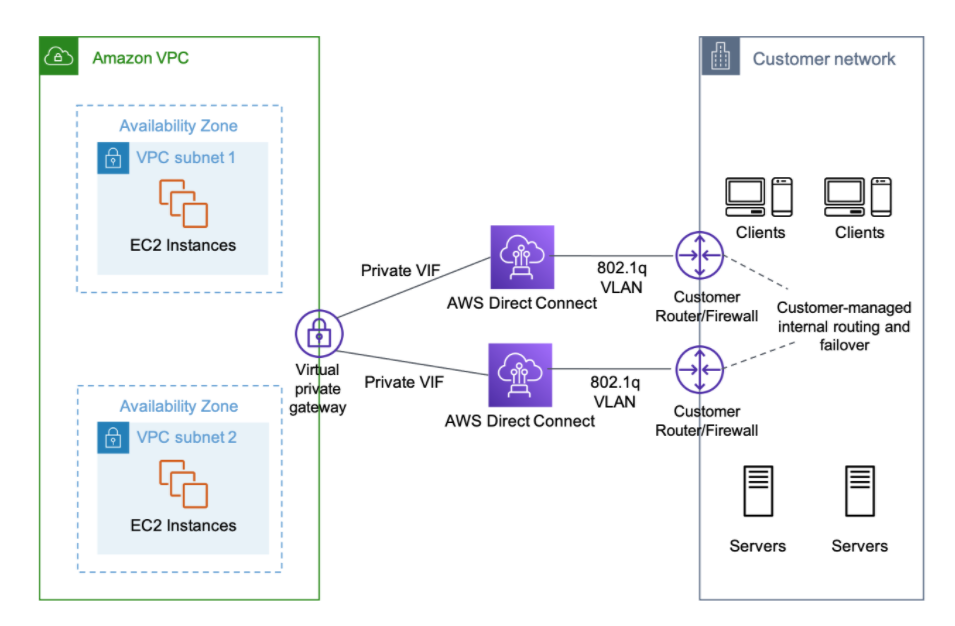
With Client VPN, we can access our resources from any location using an OpenVPN-based VPN client.
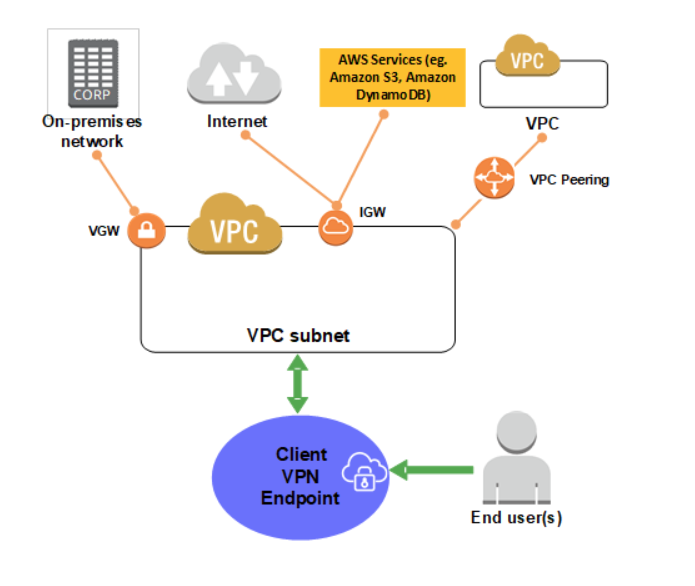
A VPC peering connection is a networking connection between two VPCs that enables us to route traffic between them. Instances in either VPC can communicate with each other as if they are within the same network. We can create a VPC peering connection between our own VPCs, or with a VPC in another AWS account. The VPCs can be in different regions (also known as an inter-region VPC peering connection).


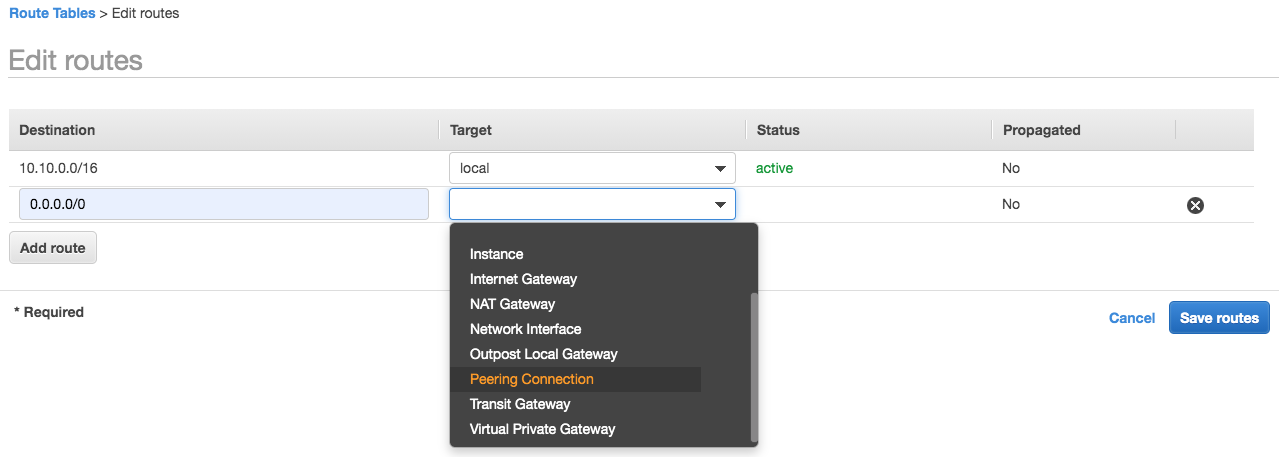
With large number of VPCs, Transit Gateway provides simpler VPC-to-VPC communication management over VPC Peering. Note that the transit hub can be used to interconnect not only our VPCs but also on-premises networks.
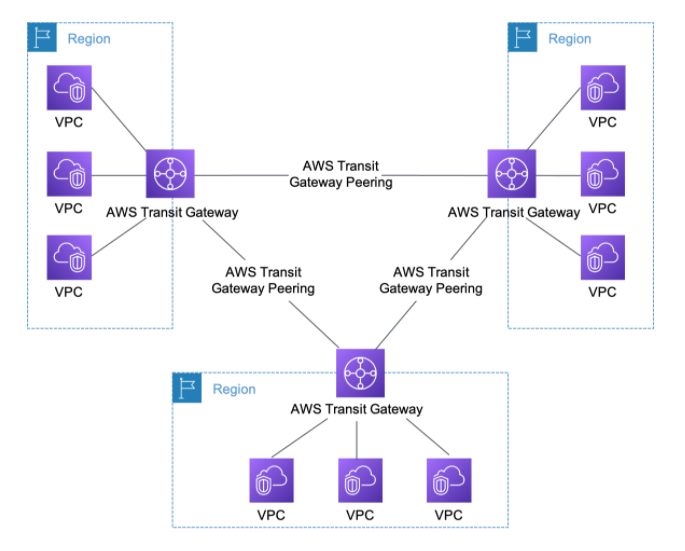
The Transit Gateway provides a hub and spoke design for connecting VPCs and on-premises networks as a fully managed service without VPN overlay.
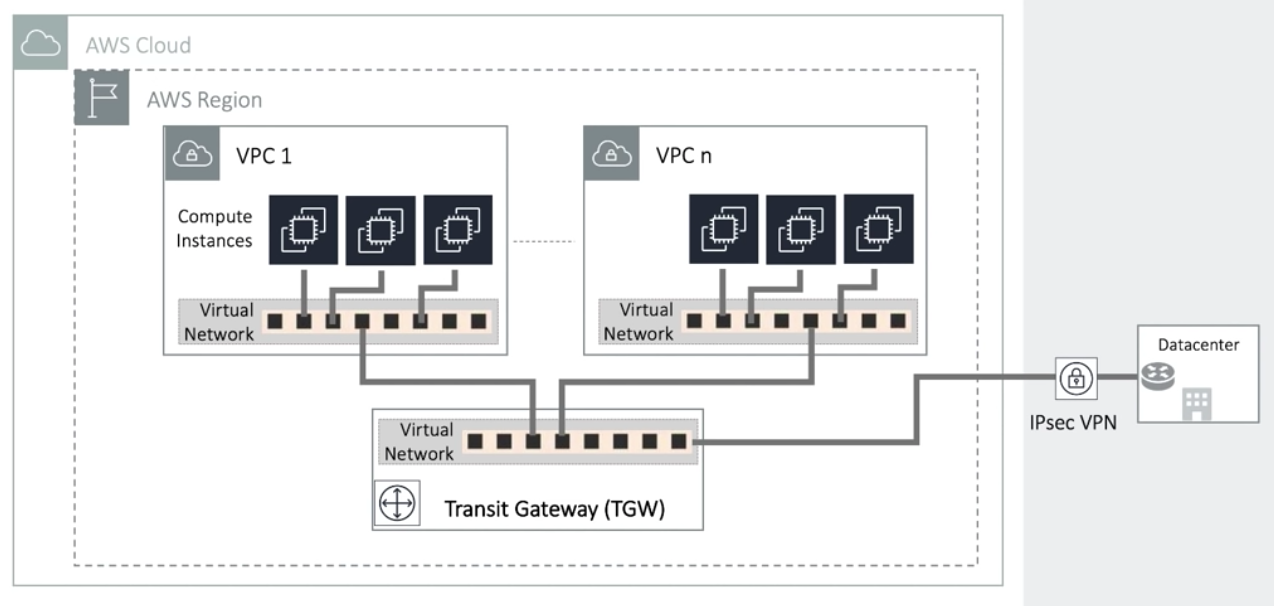
A VPC endpoint for Amazon S3 enables AWS Glue to use private IP addresses to access Amazon S3 with no exposure to the public internet. AWS Glue does not require public IP addresses, and we don't need an internet gateway, a NAT device, or a virtual private gateway in our VPC. We just use endpoint policies to control access to Amazon S3 etc. Traffic between our VPC and the AWS service does not leave the Amazon network.

There are two types of VPC endpoints:
- gateway endpoint: It is a gateway that we specify as a target for a route in our route table for traffic destined to a supported AWS service. Both Amazon S3 and Amazon DynamoDB are currently supported by gateway endpoints.
- interface endpoint: It is powered by AWS PrivateLink, and it is an elastic network interface (ENI) with a private IP address from the IP address range of our subnet that serves as an entry point for traffic destined to a supported service. Interface endpoints support a large and growing list of AWS services. See next section.
AWS PrivateLink provides private connectivity between VPCs, AWS services, and our on-premises networks, without exposing our traffic to the public internet. So, AWS PrivateLink makes it easy to connect services across different accounts and VPCs to simplify the network architecture significantly.
Other accounts and VPCs can create an VPC endpoints to access our endpoint service.
Endpoint services can be created on Network Load Balancers and Gateway Load Balancers. Services created on Network Load Balancers can be accessed using interface endpoints, while services created on Gateway Load Balancers are accessed using Gateway Load Balancer endpoints.
In the diagram below, the account owner of VPC B is a service provider, and has a service running on instances in subnet B. The owner of VPC B has a service endpoint (vpce-svc-1234) with an associated Network Load Balancer that points to the instances in subnet B as targets.
Instances in subnet A of VPC A use an interface endpoint to access the services in subnet B.
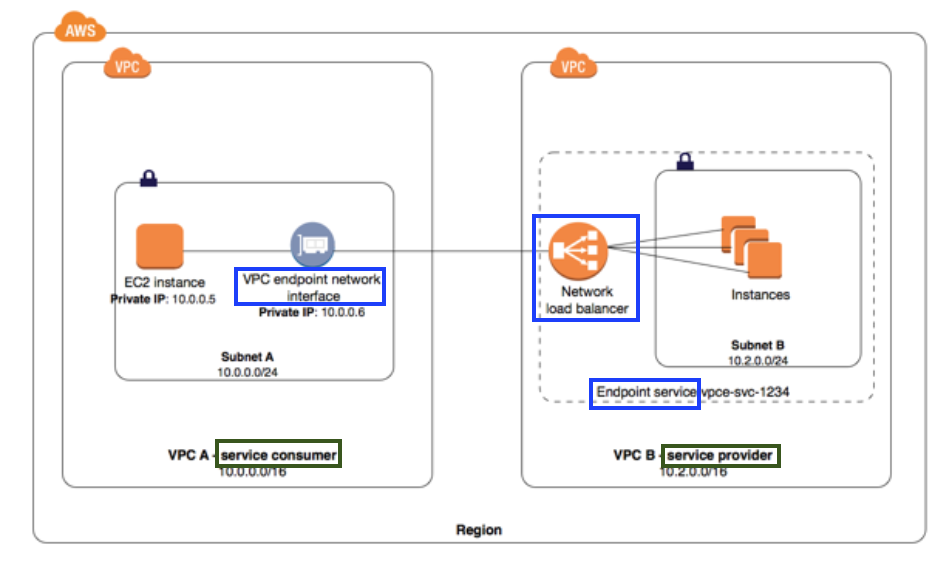
VPC endpoint services for interface endpoints
In the following diagram, the owner of VPC B is the service provider, and it has configured a Network Load Balancer with targets in two different Availability Zones. The service consumer (VPC A) has created interface endpoints in the same two Availability Zones in their VPC. Requests to the service from instances in VPC A can use either interface endpoint.
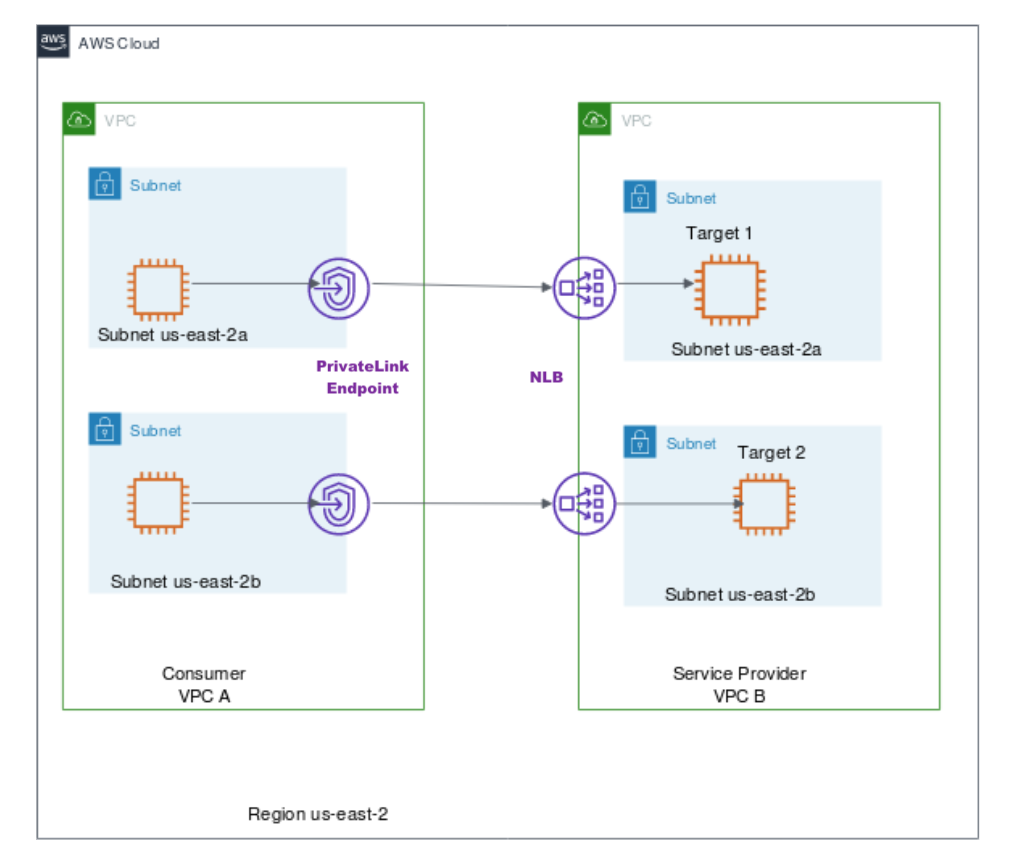
VPC endpoint services for interface endpoints
The PrivateLink enables us to connect to some AWS services, services hosted by other AWS accounts (referred to as endpoint services), and supported AWS Marketplace partner services, via private IP addresses in our VPC.
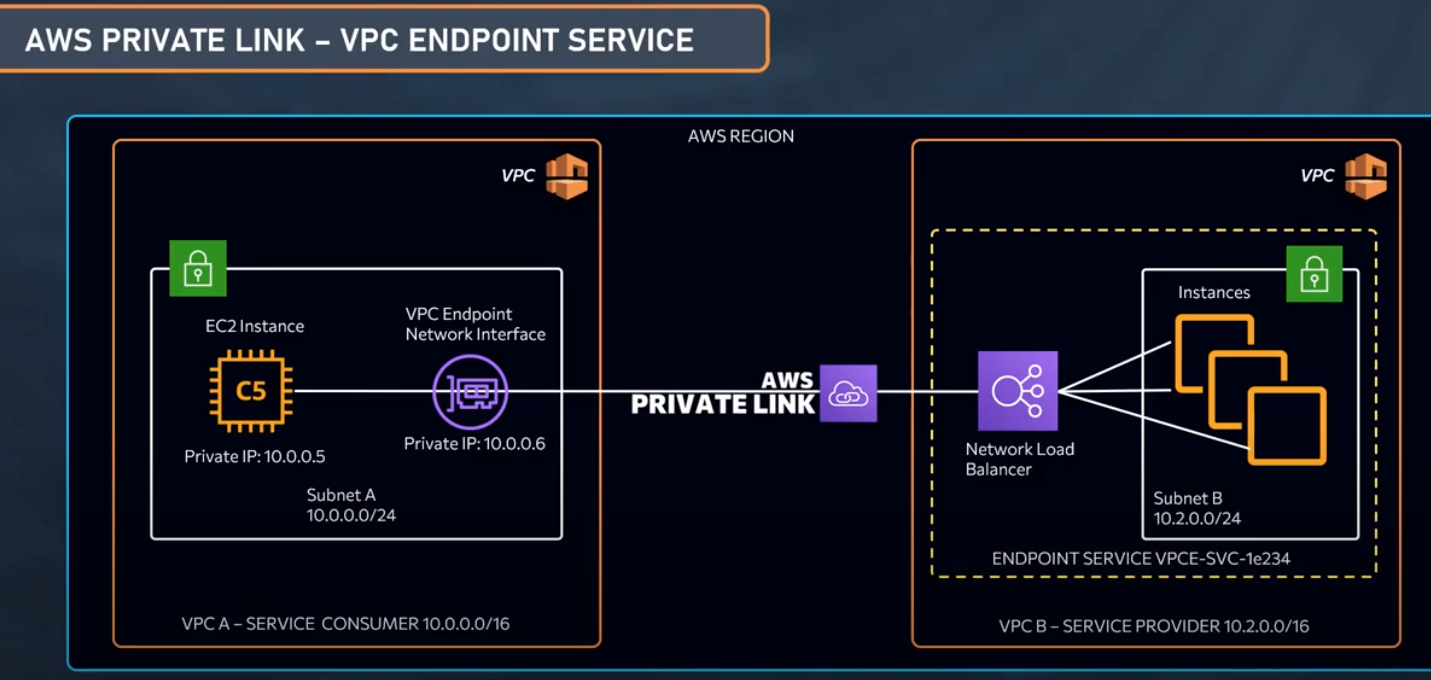
AWS PrivateLink | VPC Endpoint Service
The interface endpoints are created directly inside of our VPC, using elastic network interfaces and IP addresses in our VPC's subnets. That means that VPC Security Groups can be used to manage access to the endpoints.
Introduced in Nov 2020 but I haven't used it yet.

AWS (Amazon Web Services)
- AWS : EKS (Elastic Container Service for Kubernetes)
- AWS : Creating a snapshot (cloning an image)
- AWS : Attaching Amazon EBS volume to an instance
- AWS : Adding swap space to an attached volume via mkswap and swapon
- AWS : Creating an EC2 instance and attaching Amazon EBS volume to the instance using Python boto module with User data
- AWS : Creating an instance to a new region by copying an AMI
- AWS : S3 (Simple Storage Service) 1
- AWS : S3 (Simple Storage Service) 2 - Creating and Deleting a Bucket
- AWS : S3 (Simple Storage Service) 3 - Bucket Versioning
- AWS : S3 (Simple Storage Service) 4 - Uploading a large file
- AWS : S3 (Simple Storage Service) 5 - Uploading folders/files recursively
- AWS : S3 (Simple Storage Service) 6 - Bucket Policy for File/Folder View/Download
- AWS : S3 (Simple Storage Service) 7 - How to Copy or Move Objects from one region to another
- AWS : S3 (Simple Storage Service) 8 - Archiving S3 Data to Glacier
- AWS : Creating a CloudFront distribution with an Amazon S3 origin
- AWS : Creating VPC with CloudFormation
- AWS : WAF (Web Application Firewall) with preconfigured CloudFormation template and Web ACL for CloudFront distribution
- AWS : CloudWatch & Logs with Lambda Function / S3
- AWS : Lambda Serverless Computing with EC2, CloudWatch Alarm, SNS
- AWS : Lambda and SNS - cross account
- AWS : CLI (Command Line Interface)
- AWS : CLI (ECS with ALB & autoscaling)
- AWS : ECS with cloudformation and json task definition
- AWS Application Load Balancer (ALB) and ECS with Flask app
- AWS : Load Balancing with HAProxy (High Availability Proxy)
- AWS : VirtualBox on EC2
- AWS : NTP setup on EC2
- AWS: jq with AWS
- AWS & OpenSSL : Creating / Installing a Server SSL Certificate
- AWS : OpenVPN Access Server 2 Install
- AWS : VPC (Virtual Private Cloud) 1 - netmask, subnets, default gateway, and CIDR
- AWS : VPC (Virtual Private Cloud) 2 - VPC Wizard
- AWS : VPC (Virtual Private Cloud) 3 - VPC Wizard with NAT
- DevOps / Sys Admin Q & A (VI) - AWS VPC setup (public/private subnets with NAT)
- AWS - OpenVPN Protocols : PPTP, L2TP/IPsec, and OpenVPN
- AWS : Autoscaling group (ASG)
- AWS : Setting up Autoscaling Alarms and Notifications via CLI and Cloudformation
- AWS : Adding a SSH User Account on Linux Instance
- AWS : Windows Servers - Remote Desktop Connections using RDP
- AWS : Scheduled stopping and starting an instance - python & cron
- AWS : Detecting stopped instance and sending an alert email using Mandrill smtp
- AWS : Elastic Beanstalk with NodeJS
- AWS : Elastic Beanstalk Inplace/Rolling Blue/Green Deploy
- AWS : Identity and Access Management (IAM) Roles for Amazon EC2
- AWS : Identity and Access Management (IAM) Policies, sts AssumeRole, and delegate access across AWS accounts
- AWS : Identity and Access Management (IAM) sts assume role via aws cli2
- AWS : Creating IAM Roles and associating them with EC2 Instances in CloudFormation
- AWS Identity and Access Management (IAM) Roles, SSO(Single Sign On), SAML(Security Assertion Markup Language), IdP(identity provider), STS(Security Token Service), and ADFS(Active Directory Federation Services)
- AWS : Amazon Route 53
- AWS : Amazon Route 53 - DNS (Domain Name Server) setup
- AWS : Amazon Route 53 - subdomain setup and virtual host on Nginx
- AWS Amazon Route 53 : Private Hosted Zone
- AWS : SNS (Simple Notification Service) example with ELB and CloudWatch
- AWS : Lambda with AWS CloudTrail
- AWS : SQS (Simple Queue Service) with NodeJS and AWS SDK
- AWS : Redshift data warehouse
- AWS : CloudFormation
- AWS : CloudFormation Bootstrap UserData/Metadata
- AWS : CloudFormation - Creating an ASG with rolling update
- AWS : Cloudformation Cross-stack reference
- AWS : OpsWorks
- AWS : Network Load Balancer (NLB) with Autoscaling group (ASG)
- AWS CodeDeploy : Deploy an Application from GitHub
- AWS EC2 Container Service (ECS)
- AWS EC2 Container Service (ECS) II
- AWS Hello World Lambda Function
- AWS Lambda Function Q & A
- AWS Node.js Lambda Function & API Gateway
- AWS API Gateway endpoint invoking Lambda function
- AWS API Gateway invoking Lambda function with Terraform
- AWS API Gateway invoking Lambda function with Terraform - Lambda Container
- Amazon Kinesis Streams
- AWS: Kinesis Data Firehose with Lambda and ElasticSearch
- Amazon DynamoDB
- Amazon DynamoDB with Lambda and CloudWatch
- Loading DynamoDB stream to AWS Elasticsearch service with Lambda
- Amazon ML (Machine Learning)
- Simple Systems Manager (SSM)
- AWS : RDS Connecting to a DB Instance Running the SQL Server Database Engine
- AWS : RDS Importing and Exporting SQL Server Data
- AWS : RDS PostgreSQL & pgAdmin III
- AWS : RDS PostgreSQL 2 - Creating/Deleting a Table
- AWS : MySQL Replication : Master-slave
- AWS : MySQL backup & restore
- AWS RDS : Cross-Region Read Replicas for MySQL and Snapshots for PostgreSQL
- AWS : Restoring Postgres on EC2 instance from S3 backup
- AWS : Q & A
- AWS : Security
- AWS : Security groups vs. network ACLs
- AWS : Scaling-Up
- AWS : Networking
- AWS : Single Sign-on (SSO) with Okta
- AWS : JIT (Just-in-Time) with Okta
Ph.D. / Golden Gate Ave, San Francisco / Seoul National Univ / Carnegie Mellon / UC Berkeley / DevOps / Deep Learning / Visualization